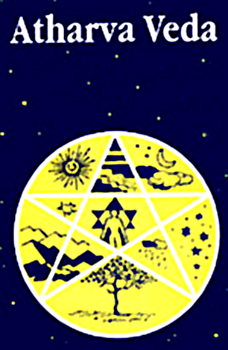 The prayers for health and long life, called by the Indians Ayusyani Suktani, i.e. hymns for achieving long life, form the second class of the hymns of the Atharva Veda. They are only a little different from the magic spells for healing. These are prayers, as they were used chiefly at family festivals, as the first hair-cutting of the boy, the first shaving of its youth, and the initiation (Upanayana). The prayers for a great age, for a life of "a hundred autumns" and for protection against all sorts of diseases, are recorded here again and again in a rather monotonous manner. Book XVII consisting of a single hymn of thirty stanzas, belongs to this class of hymns. As in the spells of healing, the healing here which the magic-doctor uses is often invoked, so some of the prayers for long life are addressed to amulets which are to ensure health and long life to the wearer.
The prayers for health and long life, called by the Indians Ayusyani Suktani, i.e. hymns for achieving long life, form the second class of the hymns of the Atharva Veda. They are only a little different from the magic spells for healing. These are prayers, as they were used chiefly at family festivals, as the first hair-cutting of the boy, the first shaving of its youth, and the initiation (Upanayana). The prayers for a great age, for a life of "a hundred autumns" and for protection against all sorts of diseases, are recorded here again and again in a rather monotonous manner. Book XVII consisting of a single hymn of thirty stanzas, belongs to this class of hymns. As in the spells of healing, the healing here which the magic-doctor uses is often invoked, so some of the prayers for long life are addressed to amulets which are to ensure health and long life to the wearer.
In the closest connection with these prayers are the extremely numerous benedictions (Paustikani), by means of which the farmer, the shepherd, the merchant hope to gain happiness and success in their undertakings. Here we find a prayer which is used at the building of a house, benedictions for ploughing, for sowing, for the growth of the corn, and exorcisms against field-vermin, spells against the danger of fire, prayers for rain used in rain-magic, numerous benedictions for the prosperity of the herds of cattle, exorcisms of a herdsman against wild animals and robbers, prayers of a merchant for good business and good fortune on his journey, of a gamester for good luck with the dice, proscriptions and exorcisms against snakes, and so on. Only a few of these songs and spells are of any worth as poetry. It frequently happens, however, that in a very mediocre poem of considerable length we find single verses of great beauty. The most beautiful is perhaps the rain-song of the Atharva Veda.
The least amount of poetry is found in those benedictions which contain only quite general prayers for happiness or for protection against danger and evil. Among the latter are the so-called "Mrgarasuktani" (Atharva Veda IV, 23-29), a litany consisting of seven hymns of seven verses each. They are addressed respectively to Lord Agni, Indra, Vayu and Savitar, Dayus and Prithvi (heaven and earth), the Maruts, Bhava and Sarva, Mitra and Lord Varuna and every verse concludes with the refrain-like prayer for deliverance from affliction.
The class of hymns in the Atharva Veda dealing with expiatory ceremonies are known as Prayascittani. These expiatory formula and spells for cleansing from guilt and sin are less different from the spells of healing than one might think. For, an expiation, a Prayascitta, is necessary not only for "sins" in the normal sense, i.e. offences against the moral rule, or transgressions against religion, but by the side of propitiatory formulae for imperfectly performed sacrifices and ceremonies, for crimes consciously and unconsciously committed, for sins thought, for non-payment of debts, especially gambling debt, for the marriage (prohibited by the law) of a younger brother before the elder, and beside general prayers for liberation from guilt and sin and their consequences. One can also find propitiatory formulas, and, in connection with atonement ceremonies, songs and spells by which mental and physical infirmities, unpropitious omens (e.g. the birth of a child under an unlucky star), bad dreams and sudden accidents are "expiated," i.e., warded off or weakened in their effects. The conception of "guilt," "sin," "evil," "misfortune" are continually merged one into the other.
The fact is that everything evil -disease and misfortune, just the same as guilt and sin- is looked upon as caused by evil spirits. Like the invalid or the madman, so is the evil-doer, the sinner, possessed by a wickeder demon. The same fiends which bring disease also send the unfavourable omens and the accidents themselves. Thus the prayers for health and long life are aimed at warding of these evil spirits.













